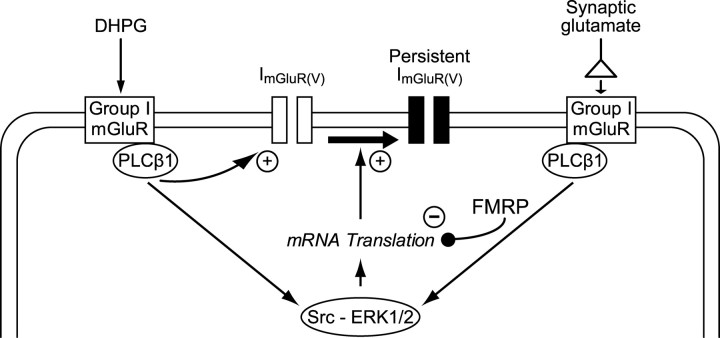Figure 8.
Schematic representation of the effects of group I mGluR stimulation in hippocampal CA3 pyramidal cells. Group I mGluRs activated by DHPG and by synaptic glutamate are depicted separately for clarity. DHPG is likely to activate extrasynaptic and synaptic group I mGluRs. Model of persistent activation of ImGluR(V): DHPG action (left side of the scheme). DHPG activates ImGluR(V) via stimulation of mGluR1 and mGluR5 through PLCβ1-mediated signaling (Chuang et al., 2001). Stimulation of group I mGluRs also activates protein synthesis via Src tyrosine kinase-ERK1/2 signaling-dependent mRNA translation. The group I mGluR-mediated protein synthesis is required to induce long-lasting ImGluR(V) (thick arrow). FMRP regulation of synaptic group I mGluR-mediated mRNA translation: Synaptic glutamate (right side of the scheme). Synaptic stimulation of group I mGluRs is elicited by spontaneous synchronized discharges of CA3 pyramidal cells in the presence of bicuculline (Chuang et al., 2005). Prolonged periods of synaptic stimulation of group I mGluRs induced persistent ImGluR(V) in Fmr1−/− preparations, whereas similar pattern of stimulation was ineffective in ImGluR(V) activation in wild-type preparations. Presumably, ImGluR(V) induction is prevented by FMRP in the wild-type preparation. Whereas synaptic induction of ImGluR(V) is prevented in the wild type by FMRP, we note that DHPG is effective in the induction of ImGluR(V) in the same preparation. There are at least two possible explanations for the difference in synaptic- versus agonist-induced responses in the wild-type preparation. (1) Only synaptic group I mGluRs are regulated by FMRP, whereas DHPG activates also nonsynaptic group I mGluRs which are not subject to FMRP regulation. Evidence for the inhibitory role of FMRP on synaptically activated prolonged epileptiform discharges is from data in Figure 7, showing that synaptic activation of group I mGluRs can elicit epileptogenesis in the absence of FMRP (Fmr1−/− preparations) but not in the presence of functional FMRP (wild-type preparations). (2) Stimulation of group I mGluRs by DHPG leads to downregulation of FMRP function, possibly via activation of the ubiquitin-proteasome system (Hou et al., 2006), whereas synaptic stimulation does not affect FMRP levels.

